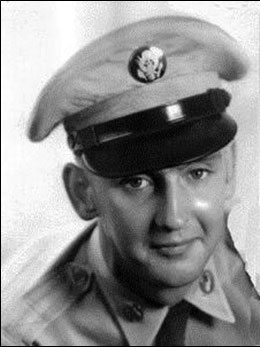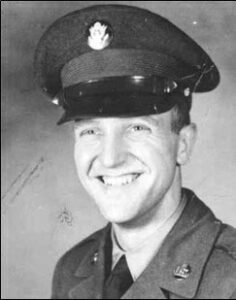Frederick & Washington Counties’
Lost in the Forgotten War (Part 2)
by Priscilla Rall
PFC Kenneth Lee Smith
In September 1950, while the United States was holding onto the southeast corner of South Korea by a thread, Gen. Douglas MacArthur was planning a surprise amphibious landing at Inchon along the western coast of Korea just west of Seoul. A shameless publicity hound, MacArthur’s PR men presented the invasion as “brilliant” and unparalleled in history except the plan was neither brilliant nor an extraordinary concept. It was standard army doctrine for peninsular warfare. In WWII, it was used at Salerno and Anzio. In fact, the Pentagon had produced plan SL-17 on June 19, 1950, that anticipated a North Korean invasion, a U.S. retreat to Pusan, and then an amphibious landing at Inchon! MacArthur’s headquarters requested 50 copies of SL-17 on June 26.
The invasion forces consisted of almost 70,000 men, including PFC Kenneth Lee Smith, from Cavetown in Washington County. who was a Marine with D/2/5. The amphibious attack began early Sept. 15. Lt. Col. Raymond Murray’s 5th Marines led the assault and landed on the northernmost Red Beach. After coming ashore, PFC Smith with D Co. marched inland. The next day, the 5th Marines were then ordered to drive through the southern section of Inchon. The 2/5 Marines led off that morning with D Co. Then, in the early hours of Sept. 24, the enemy began a counter-attack with their main effort aimed at the 2nd Bn.’s D Co. Unbeknownst to the Americans, they were facing 10,000 seasoned enemy troops. D Co. was hampered in their assault by a greatly diminished visibility caused by a combination of fog and smoke. Without warning, PFC Smith’s company came face to face with the enemy who soon had them pinned down. When D Company finally took the ridge, only 27 men of D Co. remained standing to savor their bittersweet victory. They had begun the battle with 206 officers and men. The fight had cost the company 36 KIA, 116 were wounded severely enough to require evacuation, including PFC Kenneth Smith, who died of his wounds two days later, on September. 26, 1950, after having been in constant combat since coming ashore at Inchon. He was buried in Rest Haven Cemetery in Hagerstown.
Cpl. Paul K. Carty,
Sgt. Roy Charles Delauter,
Cpl. Kenneth Lee Ridge
MacArthur was flush with victory after Inchon and taking Seoul and wanted to follow his victories up with an offense aimed to push out all of the North Korean troops north to the Yalu, the border with China. He discounted any intelligence which suggested that the Chinese were planning to join the North Koreans. With little thought, he divided his troops on the east and west side of the Korean peninsula with a high ridge of mountains between them. On the east was the large frozen Chosin reservoir. On its eastern shore were three soldiers with Task Force MacLean (later called Task Force Faith) from Western Maryland, Cpl. Paul K. Carty with the Headquarters’ Company, 57th Field Artillery Battalion; Sgt. Roy Charles Delauter with D/1/32; and Cpl. Kenneth Lee Ridge with M/3/31 who was born in 1930 in Hagerstown, the son of Melvin George and Mae Anna Funk Ridge.
Unbelievably, they had not been provided with wire, mines, or flares to create an effective perimeter with. At 9 p.m., a small Chinese patrol was discovered, and one enemy was captured. Col. Faith called a meeting of all of company commanders to review the offense scheduled for the next day. While this was going on, the enemy attacked the 3rd Platoon of C Co. but were driven off.
At 8 a.m., the battalion took to the offense and managed to drive back the Chinese and recover most of the lost territory. During the day, Gen. Almond arrived by helicopter, and was told by Col. Faith of the Chinese attack. He discounted Col. Faith’s estimated size of the enemy forces saying, “Don’t worry. You’re only fighting remnants fleeing northwards.” About this time, the 3rd Battalion of the 31st Infantry with Ridge and the 57th Field Artillery Battalion with Carty reached their position four miles south of Faith’s 1/32. At 10:30 p.m., the Chinese again attacked. Sgt. Delauter’s D Co. held fast, holding back the Chinese. Finally, at 2:30 a.m., Nov. 29, the Chinese withdrew. Just one hour later, the battalion was ordered to withdraw south and consolidate with the 3/32 which had also been under similar enemy attacks.
As they struggled to ready the troops for the retreat, it began to snow furiously. The main withdrawal got underway at 5:30 a.m., Nov. 29. Soon MacLean was shot and captured; Col. Faith took command of the troops, now called Task Force Faith. They would need every ounce of faith to get them through to safety. He led his men in the attack of the unsuspecting Chinese encircling the 3/31. Finally, the Americans were together, hoping that they could fight their way south to Hagaru-ri. But the situation was dire. They were surrounded on three sides by the Chinese. Supplies were running low. The soldiers had been rushed forward with little preparation and few supplies. Their Medical Company had been destroyed in an ambush. As the troops were consolidated, Col. Faith’s drive and will-power strengthened the soldiers’ morale considerably. The Division Commander flew in to confer with Col. Faith. He was direct…there would be no help for Faith and his hardy band of men. They were on their own…written off by MacArthur’s high command. Worst of all, Faith did not know that the operation’s center of the 31st a few miles north of Hugaru had been hurriedly evacuated, without a thought given to Faith, who still believed that if they could get that far, they would find a haven of friendly troops.
Late on Nov. 30 at 10 p.m., the Chinese tried again. Then it began to snow, diminishing visibility and helping mask the American’s movements. Just after midnight, the Chinese penetrated the perimeter, and began to infiltrate many of the U.S. positions. Task Force Faith was fighting for its life. The medics were out of bandages and morphine. Few had eaten anything for two days. The cold was debilitating, particularly as the soldiers did not have cold weather gear. They had no first aid tents, so the medics slung a tarp over a railroad cut for shelter. They had no stoves to warm the wounded.
While the Americans were finalizing their plans for the offense, Chinese attacked the Americans dug in around the inlet just after midnight, overwhelming K, L, and I Companies and the CP. Sgt. Roy “Bud” Delauter, with D/1/32, was at the northernmost point of Col. Faith’s position. From Wolfsville, he was the son of Roy and G. Rae Delauter and the husband of Shirley Viola Brown Delauter and was killed on Dec. 1 and is listed as MIA. His brother, Boyd was wounded at the same time, but recovered.
Cpl. Ridge and his Heavy Weapons Company was the only company that held fast throughout that first night. M Co. and a few small isolated units were not penetrated nor overrun. The Chinese withdrew at sunrise just as the battalion was near collapse. That night, the Chinese resumed their attacks. The next day, Col. Faith and his 1/32 joined the 3/31 and the 57 FAB. As Col. MacLean, who had been cut off with Faith, neared his position, he was wounded and then captured. Col. Faith took over the remaining troops. Faith led the soldiers through unrelenting enemy pressure south towards safety at Hagaru. The Army suffered terribly from the relentless cold, snow and winds. Unlike the Marines, the soldiers were not supplied with cold weather gear. From his heated headquarters in Japan, the army quartermaster decided in late October that “arctic items will not be necessary.” Contrary to the facts, MacArthur reassured the public that all those in the military were equipped with “suitable cold weather clothing.” In stark contrast, Gen. Almond on Nov. 17 wrote an urgent appeal for stoves and heated tents. “Soldiers are freezing for a lack of shelter.” On that day, the 7th Div. was short 6,700 mountain sleeping bags!
As Col. Faith organized the final thrust to break through the Chinese blockades, the Air Force promised air coverage for the breakout beginning at noon, but they were one hour late. Just as the soldiers were setting out, the Marine planes came flying in, dropping canisters of napalm on the Americans! As many as 30 soldiers are believed to have been killed in this tragic act of friendly fire.
For the Ridge family, 1950 was a doubly tragic year. Kenneth’s older brother, Lauren Ridge, a Maryland State Trooper, was killed in the line of duty just four months before Kenneth died in Korea. TFC Ridge, an Army Air Corps veteran of WWII had survived Pearl Harbor, but died on the streets of Hagerstown, shot by a deranged man whom he was trying to disarm. TFC Ridge left behind a wife and 18 month-old son.
If you are a veteran or know a veteran who is willing to tell his or her story, contact the Frederick County Veterans History Project at priscillarall@gmail.com.

Kenneth Lee Ridge

Paul K. Carty
Photos Courtesy of Priscilla Rall

